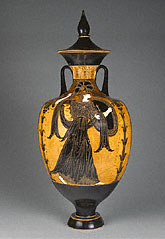• What do you think this lidded pot was used for? What about its design led you to your conclusion?
(To store a large amount of liquid. It has a lid to preserve the contents inside and two handles for pouring.
The narrow neck, in contrast to the bulbous body, is also good for pouring but not for reaching into.)
• This
amphora was made as a trophy for the victor in a boxing competition. Who do you think the winged figure on the
back of the vase represents, and what is she doing? (The winged figure is the goddess
Nike. She represents victory and is
crowning the winner of the boxing match with a wreath that signifies him as the champion.)
• Look carefully at the figure on the front of the vase. What can you tell about who she is, based on what she is wearing
and holding? (She is the Greek goddess
Athena. The shield, helmet, and breastplate with the head of Medusa are objects closely associated with her. Objects associated with people or gods like this are called attributes.)
• This vase is decorated with
black-figure painting. The artists who made this would have painted diluted black clay over
the body of the vessel and scraped away the paint to allow the red background to show through. Where can we see evidence of this
technique? (In the clothing and accessories of Athena, the columns that flank the goddess, the design
motifs around the neck of the vessel, and the bodies of Nike, the judges, and the boxers.) |
The
Panathenaia, a state religious festival, honored Athena, the patron goddess of Athens. Held in its expanded form every four
years, the festival included athletic, musical, and other competitions. Amphorae filled with precious olive oil were given as
prizes in the Panathenaic Games. These vessels had a special form, with a narrow neck and foot and a standard fashion of
decoration. One side showed Athena, the goddess of war, armed and striding forth between columns, and included the
inscription "from the games at Athens." The other side showed the event for which the vase was a prize. Leading vase painters,
commissioned by the state, decorated these vessels, which continued to be ornamented in the black-figure technique (probably due
to religious conservatism) long after it had gone out of fashion for other vases. The Nike figures atop
acanthus columns flanking
Athena are a unique detail that allows scholars to date this vase precisely to 363–362 B.C.
The back of the vase depicts Nike, the goddess of victory, crowning the winner of a boxing match between young men, while an
older, bearded judge looks on. The strips of leather held by the youths identify them as boxers; they would wrap the strips
around their hands to serve as the ancient equivalent of boxing gloves. In 370 B.C. the victor in youth boxing won forty amphorae
of oil; the second-place winner took home eight.
The city of Athens was the leading producer of painted Greek vases in the 500s and 400s B.C. when its vases completely dominated
the pottery market of the Mediterranean. The success of Athenian pottery was partially due to the quality of local clay. The
mineral content of Attic (from Athens) clay allowed for a lustrous and durable finish on the fired vase, which appealed greatly to consumers.
But the success of Athenian pottery was also due to its decoration. For the Greeks, "man was the measure of all things," and the
decoration of Athenian vases exploited this fascination with the human figure. The images tell vivid stories of real people going
about their favorite activities and mythological gods and heroes performing legendary deeds.
About the Artist
Nikodemos was a potter working in the city of Athens in the years around 362 B.C. He is known only from his signature,
Nikodemos epoiesen (Nikodemos made it), on this Panathenaic amphora in the Getty Museum. Nikodemos could have shaped
the vase with his own hands, or he might have owned the workshop in which the vase was produced, with the signature functioning
like a trademark.
|
